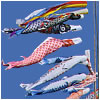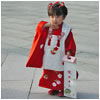Learn About Japan > Japan Through the Year > Cultural Holidays > Boys' Day, Children's Day, or Tango no Sekku (May 5)

|

Cultural Holidays
- Calendars in Japan
- Fortune Calendar (Rokuyō)
- Events of the New Year's Period: Matsunouchi and Koshōgatsu
- Bean Throwing Day or Setsubun (February 3)
- Valentine’s Day (February 14)
- Doll Festival (March 3)
- White Day (March 14)
- Cherry Blossom Viewing Season or Hanami (late March to early April)
- Boys' Day, Children's Day, or Tango no Sekku (May 5)
- Mother’s Day (second Sunday in May)
- Father’s Day (third Sunday in June)
- Star Festival or Tanabata (July 7)
- Summer Greetings or Shochū Mimai (late July to early August)
- Summer Gift-Giving Season or Ochūgen
- Obon
- Seven-Five-Three or Shichigosan (November 15)
- Christmas Day (December 25)
- Winter Gift Giving Season or Oseibo
|

Carp windsocks fly in honor of boys day.
Photo Courtesy of Shimoyamamura Town Hall.
Boys' Day, Children's Day, or Tango no Sekku (May 5)
The modern Tango no Sekku on May 5th is a festival to pray for the health and courage of boys. Families with sons celebrate this day by flying carp-shaped windsocks called koinobori. They decorate their houses with samurai armor and warrior dolls, and eat seasoned rice cooked in bamboo leaves and sticky rice balls filled with red bean paste. Tradition says that taking a bath with iris leaves on this day drives diseases away, which is why this holiday is also called the Iris Festival (shōbu no sekku).
Tango no sekku originally came from China. By the Nara period (538-795), the imperial court already made it a custom to display irises on this day to drive evil away. When the warrior class took political leadership after 1192, the government started promoting Tango no Sekku to encourage martial spirit because the Japanese words for ‘iris’ and ‘martial spirit’ (‘shōbu’) are homonyms. Thus, this holiday also became a day to pray for boys to grow up brave and strong. In Japan, carp are known to be strong fish that can leap up waterfalls. The koinobori symbolize parents’ wishes for their sons to be as strong as carp.
|
|
|
| Download Podcast in
English
| Japanese
|
|
Document |
Audio-Video |
Chart |
Picture |
Map
|
|

